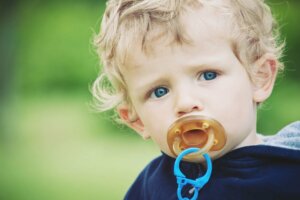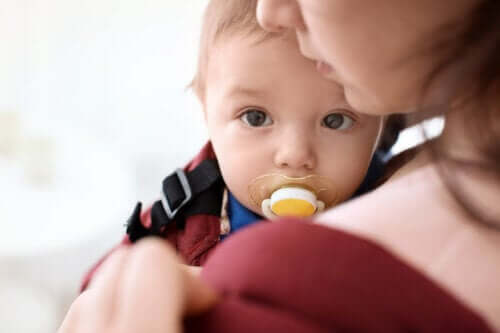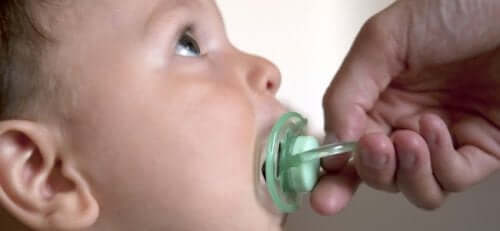The Emotional Function of Pacifiers


Written and verified by the psychologist Elena Sanz Martín
These days, pacifier use in babies is widespread and completely normal. In fact, many parents have come to consider them to be an essential element that babies can’t go without. In reality, not every baby needs one, and there are even some babies that reject them altogether. Therefore, before you establish your position on the subject, it’s important to understand the emotional function of pacifiers.
As parents, we make decisions based on what we believe is most beneficial for our children. Every home and every family goes through different circumstances and, therefore, it’s impossible to make generalizations about what’s best. That being said, any decision that you make will be the right one, as long as you make it from an informed position.
The importance of suction for babies
The suckling reflex accompanies babies from the time they’re born, as this pattern begins to develop while they’re still in the womb. Just the same, suction has to do with much more than a baby’s nutritional needs. It also helps little ones develop neurologically and favor the appearance of speech. But, above all, it exercises a calming and tranquilizing effect on babies.
At the same time, maternal breastfeeding isn’t just about nutrition. It’s also a source for establishing the attachment bond between mother and child. A mother’s breast provides comfort, helps with emotional regulation, and makes babies feel safe. So, it’s the optimal and natural means to cover a child’s emotional needs.

For the same reason, pacifiers also fulfill the function of allowing children to suckle repeatedly. So, when babies use pacifiers they calm down and experience pleasant sensations. However, objects can never replace humans. So, even though pacifiers allow babies to suckle, they don’t offer a mother’s physical contact and affection… And that’s exactly what little ones need.
The emotional function of pacifiers
It turns out that many mothers can’t or decide not to implement breastfeeding. And for one reason or another, others choose to breastfeed their babies but not always on-demand. Perhaps their work obligations force them to be away from their babies for long periods of time… Or maybe they suffer from mastitis or chapped nipples… or maybe it’s just a matter of simple exhaustion from the excessive demands of their babies.
In these cases, pacifiers emerge as the perfect substitute for the breast by fulfilling the emotional function of calming and comforting. So, we give our babies a pacifier when they’re irritable, unsettled, won’t stop crying, when they’re in their strollers, before bed… Without a doubt, this tiny little tool calms our little ones down and helps them fall asleep. However, a pacifier isn’t always the right answer.
The excessive use of pacifiers can lead to dental malformations. At the same time, it interferes with speech development because it keeps babies from beginning to express themselves. What’s more, pacifier abuse produces dependency that results in difficulties when parents finally decide it’s time to take pacifiers away.
Upset and unsettled children who can’t stop crying need physical contact and affection, not just a piece of plastic and rubber. They need to feel taken care of, held tight, and protected by their attachment figures. The establishment of a safe bond is primordial when it comes to a child’s correct emotional attachment. And that’s something a pacifier can’t do.

Do you want your children to develop the right strategies for emotional regulation? Do you want them to become autonomous and psychologically healthy? We’re sure you do. So, you need to satisfy their emotional needs during their first years of life. A pacifier isn’t enough.
So, when is it okay to use a pacifier?
Overall, pacifiers can be an adequate ally, but they can never replace the affection and attention of parents. Children that don’t breastfeed may have a need to suckle that a bottle alone can’t satisfy.
In these cases, a pacifier can help meet that. However, what they can’t make up for are physical touch, eye contact, affection, and human warmth. It’s not enough to just give a baby a pacifier and walk away.
What’s more, it’s better to save a pacifier for when it’s truly necessary. For example, when you’re driving in the car and it’s impossible to pick your baby up and comfort him.
In order for children to learn to regulate their emotions on their own, they need someone to have fulfilled this function for them. Therefore, it’s essential for the adults in their lives to be available for them. In short, remember that what your baby really needs is you, and pacifiers are optional.
These days, pacifier use in babies is widespread and completely normal. In fact, many parents have come to consider them to be an essential element that babies can’t go without. In reality, not every baby needs one, and there are even some babies that reject them altogether. Therefore, before you establish your position on the subject, it’s important to understand the emotional function of pacifiers.
As parents, we make decisions based on what we believe is most beneficial for our children. Every home and every family goes through different circumstances and, therefore, it’s impossible to make generalizations about what’s best. That being said, any decision that you make will be the right one, as long as you make it from an informed position.
The importance of suction for babies
The suckling reflex accompanies babies from the time they’re born, as this pattern begins to develop while they’re still in the womb. Just the same, suction has to do with much more than a baby’s nutritional needs. It also helps little ones develop neurologically and favor the appearance of speech. But, above all, it exercises a calming and tranquilizing effect on babies.
At the same time, maternal breastfeeding isn’t just about nutrition. It’s also a source for establishing the attachment bond between mother and child. A mother’s breast provides comfort, helps with emotional regulation, and makes babies feel safe. So, it’s the optimal and natural means to cover a child’s emotional needs.

For the same reason, pacifiers also fulfill the function of allowing children to suckle repeatedly. So, when babies use pacifiers they calm down and experience pleasant sensations. However, objects can never replace humans. So, even though pacifiers allow babies to suckle, they don’t offer a mother’s physical contact and affection… And that’s exactly what little ones need.
The emotional function of pacifiers
It turns out that many mothers can’t or decide not to implement breastfeeding. And for one reason or another, others choose to breastfeed their babies but not always on-demand. Perhaps their work obligations force them to be away from their babies for long periods of time… Or maybe they suffer from mastitis or chapped nipples… or maybe it’s just a matter of simple exhaustion from the excessive demands of their babies.
In these cases, pacifiers emerge as the perfect substitute for the breast by fulfilling the emotional function of calming and comforting. So, we give our babies a pacifier when they’re irritable, unsettled, won’t stop crying, when they’re in their strollers, before bed… Without a doubt, this tiny little tool calms our little ones down and helps them fall asleep. However, a pacifier isn’t always the right answer.
The excessive use of pacifiers can lead to dental malformations. At the same time, it interferes with speech development because it keeps babies from beginning to express themselves. What’s more, pacifier abuse produces dependency that results in difficulties when parents finally decide it’s time to take pacifiers away.
Upset and unsettled children who can’t stop crying need physical contact and affection, not just a piece of plastic and rubber. They need to feel taken care of, held tight, and protected by their attachment figures. The establishment of a safe bond is primordial when it comes to a child’s correct emotional attachment. And that’s something a pacifier can’t do.

Do you want your children to develop the right strategies for emotional regulation? Do you want them to become autonomous and psychologically healthy? We’re sure you do. So, you need to satisfy their emotional needs during their first years of life. A pacifier isn’t enough.
So, when is it okay to use a pacifier?
Overall, pacifiers can be an adequate ally, but they can never replace the affection and attention of parents. Children that don’t breastfeed may have a need to suckle that a bottle alone can’t satisfy.
In these cases, a pacifier can help meet that. However, what they can’t make up for are physical touch, eye contact, affection, and human warmth. It’s not enough to just give a baby a pacifier and walk away.
What’s more, it’s better to save a pacifier for when it’s truly necessary. For example, when you’re driving in the car and it’s impossible to pick your baby up and comfort him.
In order for children to learn to regulate their emotions on their own, they need someone to have fulfilled this function for them. Therefore, it’s essential for the adults in their lives to be available for them. In short, remember that what your baby really needs is you, and pacifiers are optional.
All cited sources were thoroughly reviewed by our team to ensure their quality, reliability, currency, and validity. The bibliography of this article was considered reliable and of academic or scientific accuracy.
- Sánchez, L. M., González, E. D., Florensa, S. G. T., & Marti, J. G. (2000, January). Uso del chupete: beneficios y riesgos. In Anales de Pediatría (Vol. 53, No. 6, pp. 580-585). Elsevier Doyma.
- Facal, M., Pérez, A. J., & Lagarón, C. (2003). Chupetes¿ sí o no?¿ es conveniente que la madre ofrezca el chupete a su bebe? La respuesta es… A veces. Revista de ortodoncia clínica, 6(4), 206-217.
This text is provided for informational purposes only and does not replace consultation with a professional. If in doubt, consult your specialist.








